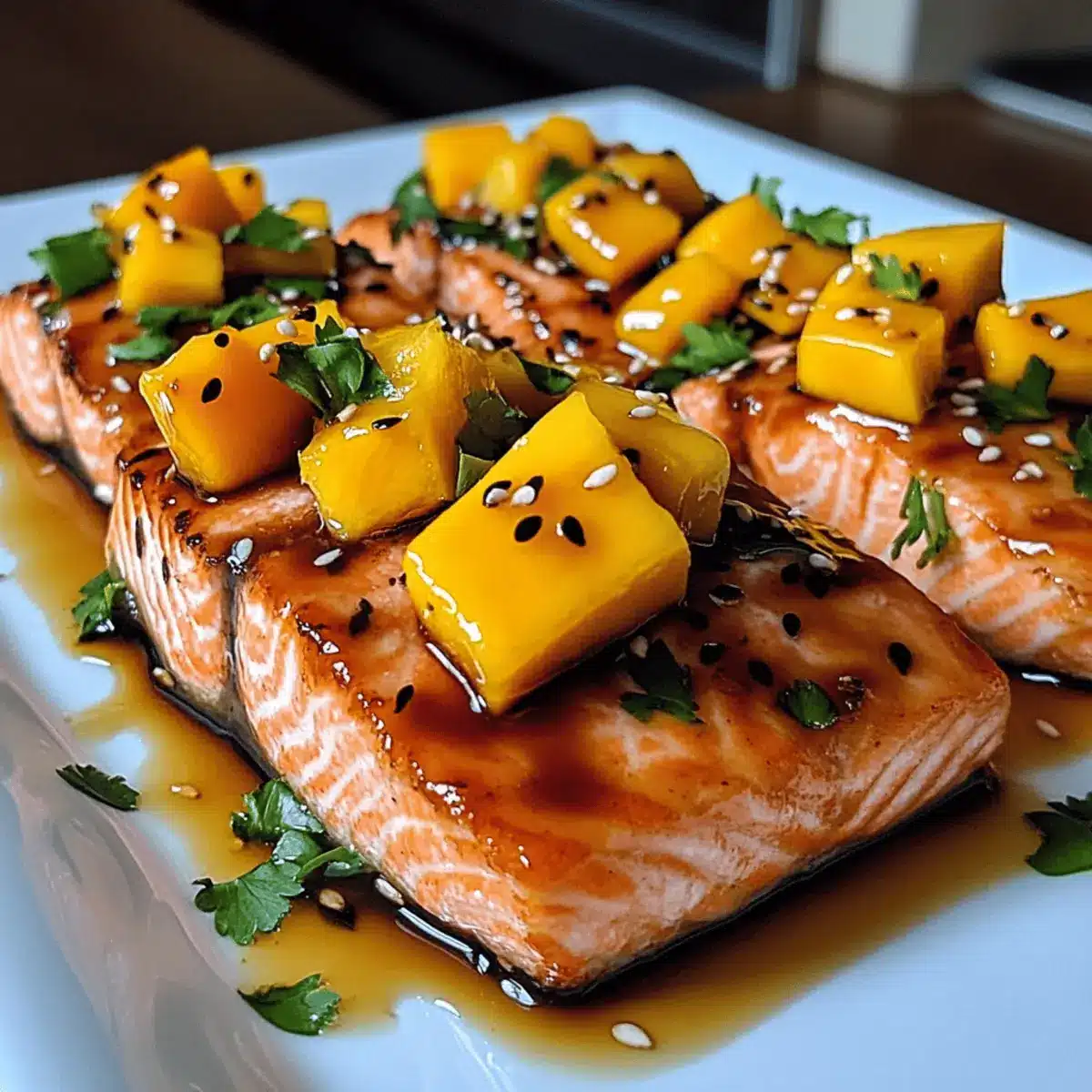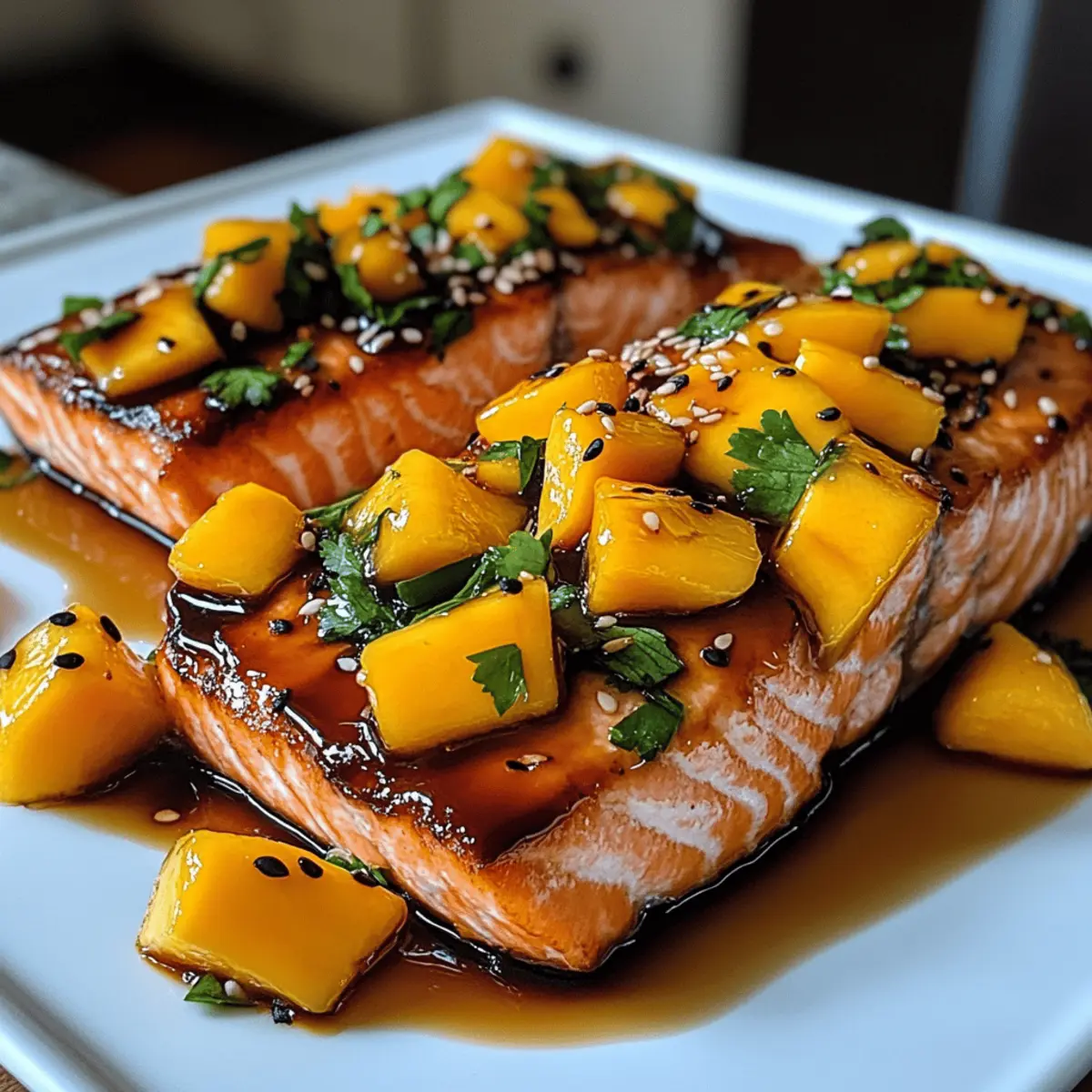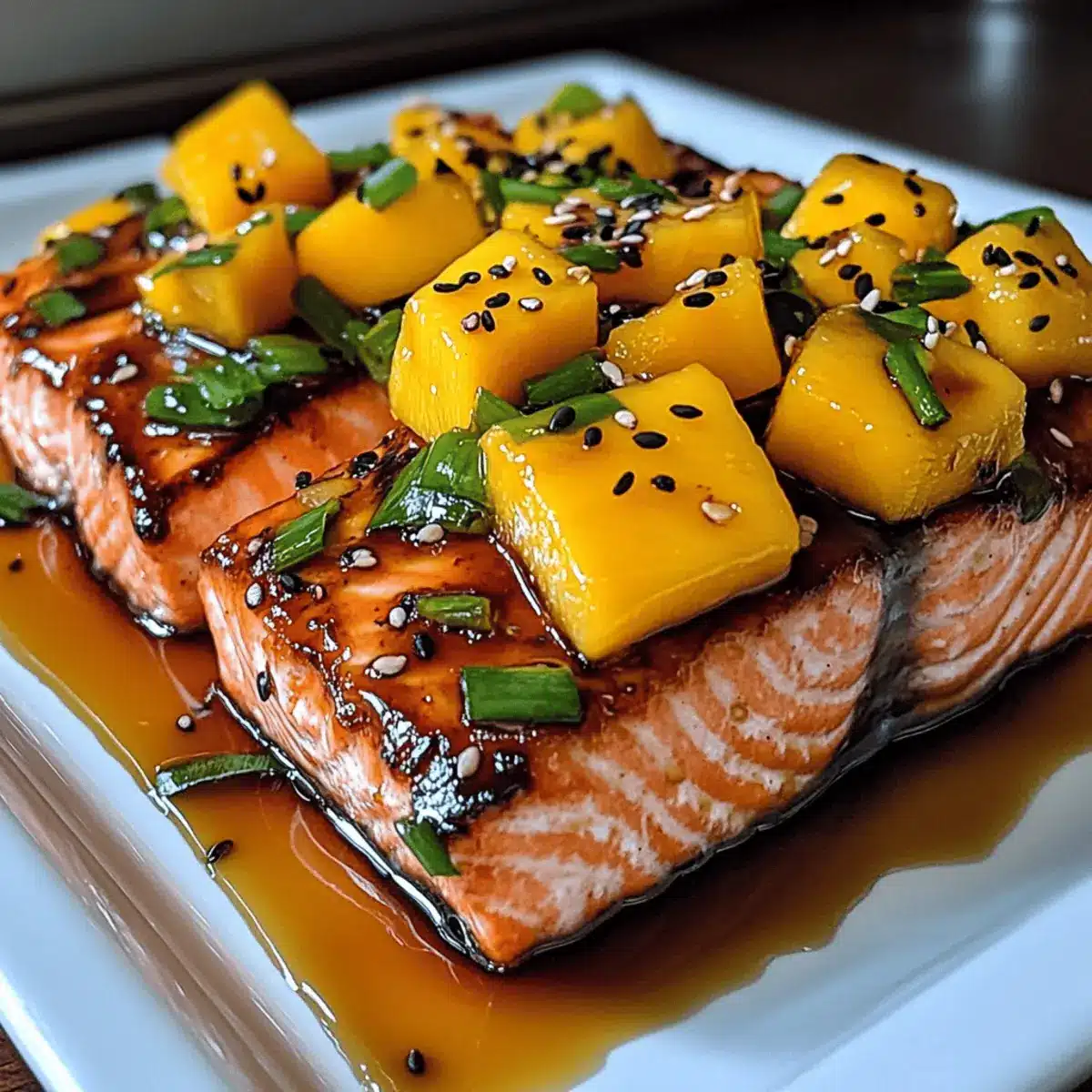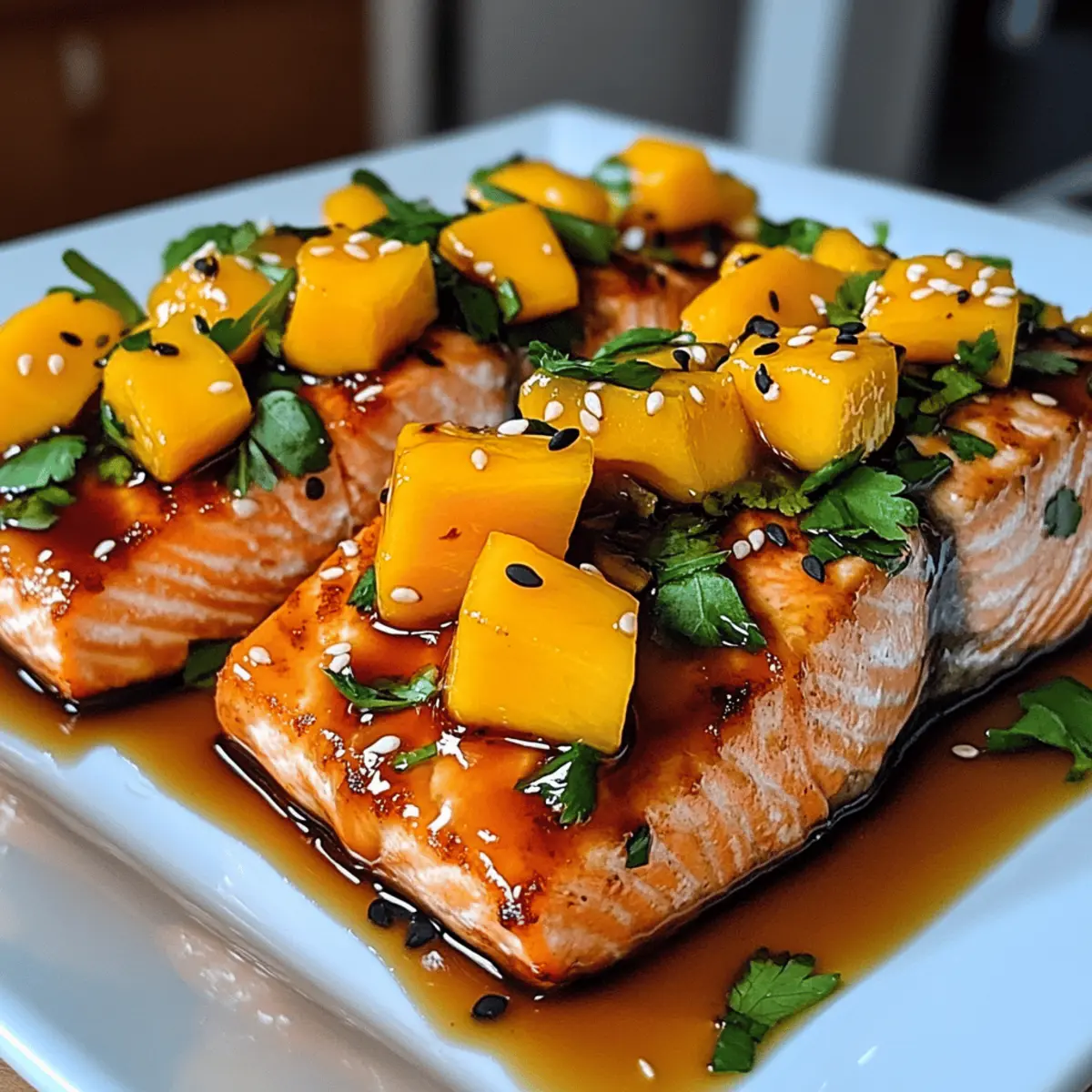As I glanced at the clock and realized dinner time was fast approaching, my mind raced through options when a spark of inspiration hit me—Mango Teriyaki Salmon! This vibrant dish perfectly combines the sweet, tropical notes of ripe mango with the savory allure of teriyaki sauce, transforming simple salmon fillets into a stunning weeknight meal. In just 30 minutes, you can whip up a healthy dinner that delights the senses while being easy on the schedule. Plus, it’s a fantastic way to enjoy a burst of nutrition that doesn’t skimp on flavor. Curious how to bring a taste of the tropics to your table tonight? Let’s dive into this delicious journey together!

Why is Mango Teriyaki Salmon Amazing?
Quick and Easy: This dish can be on your table in just 30 minutes, making it perfect for busy weeknights.
Tropical Twist: The fresh mango adds a vibrant touch that brightens up the classic teriyaki flavor, creating a meal that feels like a mini-vacation.
Healthy & Nutritious: Packed with omega-3 fatty acids from salmon and natural sweetness from mango, this recipe supports a healthy lifestyle without sacrificing taste.
Crowd-Pleaser: Whether you’re cooking for family or friends, this dish always impresses, making it a go-to for gatherings or intimate dinners.
Versatile: Feel free to switch the salmon for chicken or tofu if you’re looking to mix things up—this recipe adapts beautifully! Check out my Pearl Couscous Salmon for another quick seafood option.
With Mango Teriyaki Salmon, dinner is not just a meal; it’s an exciting culinary adventure!
Mango Teriyaki Salmon Ingredients
For the Salmon
• Salmon Fillets – the main protein, rich in omega-3 fatty acids; skinless offers a lighter option.
For the Marinade
• Teriyaki Sauce – brings savory and sweet notes; a homemade version can be a healthier option.
• Soy Sauce – enhances umami flavor; opt for low-sodium for a healthier dish or tamari to keep it gluten-free.
• Garlic – adds depth to the dish; freshly minced garlic packs the most flavor compared to powdered.
• Ginger – provides a zesty kick; fresh ginger is ideal, but powdered can substitute in a pinch.
For the Topping
• Ripe Mango – contributes natural sweetness; fresh is best, though canned or frozen works if you’re in a hurry.
• Sesame Seeds – for garnish and crunch; toasting enhances their nutty flavor, making them extra delicious!
Step‑by‑Step Instructions for Mango Teriyaki Salmon
Step 1: Prepare Marinade
In a medium bowl, whisk together teriyaki sauce, soy sauce, minced garlic, and freshly grated ginger until well combined. This mixture will create a savory base that enhances the flavors of your Mango Teriyaki Salmon. Allow the marinade to sit for a few minutes to let the flavors meld, making it even more aromatic.
Step 2: Marinate Salmon
Place the skinless salmon fillets into the marinade, ensuring they are evenly coated on all sides. Let the fillets marinate for 10 minutes at room temperature, which allows the fish to absorb the delicious teriyaki flavors while also ensuring a moist texture when cooked.
Step 3: Heat the Skillet
While the salmon marinates, heat a non-stick skillet over medium-high heat for about 2 minutes until hot. Adding a small drizzle of oil will help the salmon achieve a beautiful sear. This step is crucial, as a hot skillet ensures that the fillets cook evenly, locking in moisture.
Step 4: Cook Salmon
Carefully place the marinated salmon fillets onto the hot skillet, cooking them for 4-5 minutes per side. Watch for the fillets to turn opaque and start to flake easily when gently pressed; this indicates they are perfectly cooked. Adjust the heat if needed, ensuring a steady sizzle for even cooking.
Step 5: Add Mango
In the last minute of cooking, add the diced ripe mango to the skillet, allowing it to warm and slightly caramelize. This infusion of tropical sweetness complements the rich teriyaki taste of the salmon, bringing vibrant colors and flavors to your dish.
Step 6: Serve the Dish
Once the salmon is cooked through and the mango is tender, carefully plate the Mango Teriyaki Salmon. Top each fillet generously with the warm mango pieces, then sprinkle with toasted sesame seeds for added texture and crunch. Each bite is sure to transport you to a tropical paradise!

Make Ahead Options
Preparing your Mango Teriyaki Salmon ahead of time is a fantastic way to streamline your weeknight meals! You can marinate the salmon fillets up to 24 hours in advance; simply place them in the marinade and refrigerate to let those flavors deepen, ensuring a succulent roast. The diced mango can also be prepped and stored in an airtight container, ready to be added at the last minute—I recommend doing this no more than 3 days ahead to keep it fresh and vibrant. When you’re ready to cook, just heat your skillet and sear your marinated salmon for 4-5 minutes per side, adding the mango during the last minute for a warm, tropical finish. This prep strategy not only saves time but also guarantees your dish will be just as delicious!
Storage Tips for Mango Teriyaki Salmon
-
Fridge: Store leftovers in an airtight container for up to 3 days. Make sure the salmon is cooled to room temperature before sealing to maintain freshness.
-
Freezer: Not recommended for freezing, as thawed salmon can become mushy, losing the delightful texture you expect from this Mango Teriyaki Salmon.
-
Reheating: To reheat, gently warm the salmon in a skillet over low heat to prevent drying out. Alternatively, use the microwave in short intervals, checking to avoid overcooking.
Expert Tips for Mango Teriyaki Salmon
-
Hot Skillet Required: Ensure your skillet is well-heated before adding the salmon to achieve that essential sear and keep the moisture locked in.
-
Perfect Cook Time: Avoid overcooking by checking the salmon after 4 minutes; it should be slightly pink in the center. Aim for flaky, tender texture.
-
Marinate Wisely: Let the salmon sit in the marinade for at least 10 minutes. This step infuses the flavors into the fish and prevents dryness while cooking.
-
Fresh vs. Frozen: Always opt for fresh mango for the best flavor, but if you’re pressed for time, frozen can work. Just ensure it’s properly thawed before adding to the dish.
-
Garnish for Flavor: Toast sesame seeds before garnishing to enhance their nutty flavor. This simple touch elevates the Mango Teriyaki Salmon presentation and taste.
Mango Teriyaki Salmon Variations
Feel free to play around with flavors and ingredients to make this dish uniquely yours!
- Spicy Kick: Add red pepper flakes or a splash of Sriracha to the marinade for an exciting heat that balances the sweetness.
- Protein Swap: Substitute salmon with chicken or tofu for a different protein option without losing the essence of the dish. If you’re curious, try pairing it with my Salmon Spinach Pasta for another delightful variation.
- Herb Infusion: Toss in fresh herbs like cilantro or green onions before serving for a fresh and aromatic touch that brightens the dish.
- Tropical Mix: Combine fresh diced pineapple with mango for a vibrant tropical burst and an exciting texture twist.
- Coconut Flavor: Drizzle a bit of coconut cream over the finished dish for richness and a soft hint of tropical flavor that enhances the overall experience.
- Umami Boost: For an extra umami kick, mix in a spoonful of miso paste into the marinade before coating the salmon.
- Zesty Lime: Squeeze fresh lime juice over the dish before serving to add a zesty brightness that pairs beautifully with the sweet mango.
- Crunch Factor: Mix in chopped nuts such as cashews or almonds for an added crunch that contrasts delightfully with the flaky salmon and soft mango.
With these variations, your Mango Teriyaki Salmon will be a new adventure every time you make it!
What to Serve with Mango Teriyaki Salmon
What makes a tropical dinner even more delightful? The perfect sides to accompany your Mango Teriyaki Salmon!
Picture a meal that’s both aesthetically pleasing and bursting with flavor, enticing your senses while drawing your loved ones around the table.
- Steamed Jasmine Rice: The fluffy texture complements the savory teriyaki glaze, soaking up all those delicious flavors beautifully.
- Mango Avocado Salad: Adding creamy avocado and fresh herbs enhances the tropical vibe, creating a refreshing contrast to the salmon’s richness.
- Grilled Asparagus: With its tender crunch and slight char, asparagus adds a vibrant element that pairs wonderfully with the sweet mango.
- Quinoa Pilaf: Nutty quinoa adds a lovely bite and healthy grains to the meal, providing an earthy counterbalance to the dish’s tropical flavors.
- Coconut Rice: Slightly sweet and creamy, it evokes island vibes and enhances the overall tropical experience of your dinner.
- Chilled White Wine: Something crisp like a Sauvignon Blanc will elevate the meal and complement the dish’s fresh, fruity notes, making each sip a pleasure.
- Chocolate Mousse: For dessert, indulge in a light chocolate mousse; its richness serves as a perfect ending to the flavor-packed meal without overwhelming the palate.
- Cucumber Salad: A refreshing, crunchy complement that adds brightness and simplicity, balancing out the hearty salmon.
Each side brings a unique texture or flavor, transforming your Mango Teriyaki Salmon from a delicious dish into a full culinary experience that is sure to leave everyone smiling!

Mango Teriyaki Salmon Recipe FAQs
How do I choose ripe mangoes for this recipe?
Absolutely! When selecting ripe mangoes, look for fruit that has a slight give when gently squeezed and is fragrant at the stem end. Avoid mangoes with large dark spots, as this indicates overripeness. Ideally, you’ll want your mango to have a vibrant color that matches the variety—yellow-orange tones are usually a good sign!
What’s the best way to store leftover Mango Teriyaki Salmon?
After cooking, allow the salmon to cool to room temperature before placing it in an airtight container. It can be stored in the refrigerator for up to 3 days. To maintain its flavor and texture, make sure to tightly seal the container. If you’re reheating, do so gently to avoid drying it out!
Can I freeze Mango Teriyaki Salmon?
Not recommended! Freezing salmon typically leads to a mushier texture upon thawing, which may not yield the delightful flakiness you want. Instead, enjoy this dish fresh, or consider making extra marinade or sides that can be frozen instead!
What should I do if my salmon is overcooked?
Don’t fret! If you find your salmon a bit on the dry side, consider serving it with a sauce or additional teriyaki glaze to help moisten each bite. Next time, remember to check for doneness around the 4-minute mark, aiming for a slightly pink center and an internal temperature of 125°F (52°C) for the perfect outcome.
Is this dish suitable for people with soy allergies?
Good question! If you have a soy allergy, you’ll want to skip traditional soy sauce, as it is a key ingredient in teriyaki recipes. Instead, a soy-free alternative like coconut aminos can be used for a similar flavor profile. Always check labels to ensure that any alternative you choose aligns with your dietary needs.
Can I substitute salmon with other proteins?
Very much so! If you’re looking to mix things up, consider using chicken breast or tofu. For chicken, you can adjust the cooking time as it requires about 6-7 minutes per side. Tofu will need to be pressed and marinated similarly, and it cooks in about 3-4 minutes per side. Each alternative brings its unique flavor and texture to the dish, making it versatile for everyone!

Delicious Mango Teriyaki Salmon for a Quick Tropical Dinner
Ingredients
Equipment
Method
- In a medium bowl, whisk together teriyaki sauce, soy sauce, minced garlic, and grated ginger until well combined.
- Place the skinless salmon fillets into the marinade, ensuring they are evenly coated. Let marinate for 10 minutes.
- Heat a non-stick skillet over medium-high heat for about 2 minutes. Drizzle with a small amount of oil.
- Carefully place the marinated salmon fillets into the hot skillet, cooking for 4-5 minutes per side.
- In the last minute of cooking, add the diced mango to the skillet to warm and caramelize.
- Plate the cooked salmon, top with warm mango pieces, and sprinkle with toasted sesame seeds.

Leave a Reply